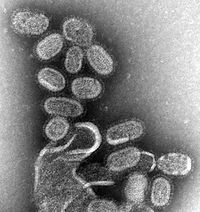
Photo from wikipedia
Until now, we have no thorough understanding the role of absolute humidity on influenza activity, especially in tropical and subtropical areas. In this study, we investigated the relationship between absolute… Click to show full abstract
Until now, we have no thorough understanding the role of absolute humidity on influenza activity, especially in tropical and subtropical areas. In this study, we investigated the relationship between absolute humidity and influenza activity in seven municipalities/provinces covering different climatic zones in China. Weekly meteorological data and influenza surveillance data in seven provinces/municipalities in China were collected from January 2012 to December 2019. A distributed lag nonlinear model was adopted to investigate the association between absolute humidity (AH) and influenza activity in each study site. Then, seven study sites were grouped into three regions: northern, intermediate, and southernmost regions. A multivariate meta-analysis was applied to estimate the exposure-lag-response associations in three regions. The province-specific or municipality-specific curves appeared to be nonlinear, and the association between influenza activity and AH varied across regions. In Beijing and Tianjin, located in northern China, the cumulative relative risks (RRs) increased as weekly average AHmean fell below 3.41 g/m3 and 6.62 g/m3. In Guangdong and Hainan, located in southernmost China, the risk of influenza activity increased with rising average AHmean with 16.74 g/m3 and 20.18 g/m3 as the break points. In Shanghai, Zhejiang, and Chongqing, the relationship between weekly average AHmean and influenza could be described as U-shaped curves, with the lowest RRs when weekly average AHmean was 11.95 g/m3, 11.94 g/m3, and 15.96 g/m3, respectively. Meta-analysis results showed the cumulative RRs significantly increased as weekly average AHmean fell below 3.86 g/m3 in the northern region, whereas significantly increased as weekly average AHmean rose above 18.46 g/m3 and 15.22 g/m3 in intermediate and southernmost regions, respectively. Both low and high AH might increase influenza risk in China, and the relationship varies geographically. Our findings suggest that public health policies for climate change adaptation should be tailored to the local climate conditions.
Journal Title: Environmental Science and Pollution Research
Year Published: 2022
Link to full text (if available)
Share on Social Media: Sign Up to like & get
recommendations!